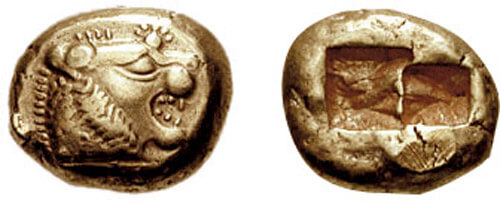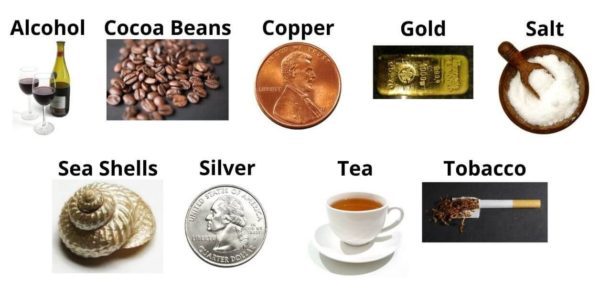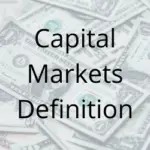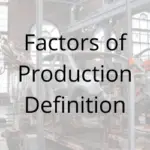Commodity Money: What it is, Why it has value & Examples

Commodity Money Definition
Commodity money is a physical good that consumers universally use to trade for other goods. In other words, it is like the money we use today, but has an actual value. For example, gold was used as money, but also in the manufacturing of jewellery. So it had value outside its use as a medium of exchange. In economics, this is known as ‘intrinsic value‘.
Commodity money is unique in the sense that it is the only form of money that has an underlying value. Even though we no longer use commodities such as gold as a form of money; it still has value as jewellery or gilding.
Key Points
- A commodity money is a physical good that has ‘intrinsic value’ – a use outside of its use as money.
- Historic examples include alcohol, cocoa beans, copper, gold, silver, salt, sea shells, tea, and tobacco.
- There are four main characteristics of commodity money – it’s durable, divisible, easily exchangeable, and rare.
We can see, touch, and feel commodity money – it is physical. Its underlying value ensures that people trust it. That means it has value in and of itself, with people trading it freely in the knowledge that someone will accept it.
By contrast, other forms of money only derive value from the trust people place in it. For example, the $10 note in your pocket is unlikely to buy much in the unlikely event the US’ stops using it as its main currency.
Origins of Commodity Money
The history of commodity money extends beyond centuries and millennia. In fact, its origins are virtually impossible to accurately determine. Nevertheless, there are records that indicate activity during the period 700-500BC when gold became a common form of money.
Photo of gold coins originally used by Lydian Merchants

Source: wikiwand | Licensed under Creative Commons License.
During this period, Lydian merchants produced a gold coin mixed with silver; otherwise known as electrum. Their aim was to help improve the efficiency of trading between countries. It was a useful store of value, it was durable, and it was widely accepted between nations. Later, in 550 B.C., under the order of King Croesus of Lydia, it went into full circulation.
Commodity Money Examples
Not all commodity money is made the same. Many have been tried and failed due to a number of factors, but here are a list of some commodity monies that have been used through history:

Some examples of Commodity money include:
- Alcohol In various cultures and throughout different time periods, alcohol has been used as a form of commodity money. This is because it holds intrinsic value, is consumable, and can serve as a medium of exchange, especially in societies where it is considered a staple or valuable good.
- Cocoa Beans In ancient Mesoamerican cultures, particularly the Mayans and Aztecs, cocoa beans were used as commodity money. Cocoa beans were valuable, tradable, and could be used to create chocolate, a luxury item.
- Copper Copper has been used as a form of commodity money due to its value and its widespread use in the production of goods. Various societies have used copper coins as a medium of exchange.
- Gold Gold is one of the most notable examples of commodity money. Due to its rarity, durability, and attractiveness, it has been used throughout history in many cultures as a medium of exchange. In modern times, gold has been used to back paper currencies, known as the gold standard.
- Salt Salt, due to its vital role in food preservation and seasoning, has been used as commodity money in numerous societies. The word ‘salary’ derives from the Latin word ‘salarium,’ which was the money paid to Roman soldiers for the purchase of salt.
- Sea Shells Particularly cowrie shells, have been used as a form of commodity money in various cultures around the world, including Africa, the South Pacific, and North America. They were portable, durable, and visually distinctive.
- Silver Like gold, silver has been used widely as commodity money. Its intrinsic value, durability, and divisibility made it an ideal form of currency. Many modern coins are made from silver or used to be made from silver.
- Tea In ancient China, tightly packed bricks of tea leaves were used as a form of currency. Tea was valuable due to its role as a staple beverage and its medicinal properties.
- Tobacco In early colonial America, especially in regions where tobacco was grown abundantly, tobacco leaves were used as commodity money. Tobacco was tradable, had intrinsic value, and was used globally, making it a feasible form of currency.
Each of these examples reflects a form of commodity money, demonstrating the variety of goods that can be used as a medium of exchange based on their intrinsic value, divisibility, and utility.
Characteristics of Commodity Money
We have already seen what commodity money is and why people trust it, but let’s dive in and see what are the characteristics of commodity money.
1. Durable
Commodities such as meat would not be effective as they go bad over time. Similarly, metals such as iron would not suffice as it rusts easily. If the commodity cannot retain its intrinsic value, then the trust in it won’t last.
2. Divisible / Measurable
We have to have a specific way of measuring money. The creation of units of measurements such as ounces and pounds paved the way for such. As a result, we are able to purchase different goods at different prices. If we cannot measure money, we cannot measure how much we are willing to pay. If there was only a $50 note in circulation; it makes it incredibly difficult to buy something at $1.
3. Easily Exchangeable
Nobody wants the inconvenience of taking a cow to market. It is far more convenient to use gold coins that are much lighter and easier to carry. The commodities that have historically taken off are all easy to trade and convenient.
4. Rarity
A commodity money has to be rare in the fact that the supply is limited. Without such, money can become almost unlimited – thereby leading to massive levels of inflation. Nevertheless, the money supply has to still be able to react to increasing economic output. That is to say, the commodity supply must be able to react to increasing demand. So when the economy starts to grow; the commodity must be able to supplied and represent the new goods in the market.
Trust in Commodity Money
In economic terms, commodity money has what is known as an ‘intrinsic value’. This means that it has a value outside of its use as money. Therefore, anything that has an alternate use could be considered a commodity form of money.
The ‘intrinsic value’ of commodity is a crucial part of building its trust. We can look back many centuries to when goods such as tobacco or salt were used as money. People would use them to trade with each other as they were commonly used goods. Even if nobody would accept it, the owner could use it for their purposes. So if someone went to market with a pound of tobacco and nobody would accept it, they would be able to smoke it instead.
Gradually, trust in commodities developed over the years. Even though traders may not accept it; the population was left reassured that it had alternate uses.
Part of the trust in commodity money also comes from its rarity, or at least how people perceive its rarity. Commodities such as gold are naturally rare, and it is because of this rareness that makes it more valuable and increases its intrinsic value. By contrast, we also have commodity monies such as salt and tobacco, which relies on its consumption and creation. In other words, how supply can be restrained.
Such commodities were not very effective. However, there was an element of trust in them. This was because, for a time, the supply was self-regulating. That is to say, farmers would produce large quantitates of tobacco, but the population would consume in equal size. Nevertheless, there was a fundamental issue in the fact that the supply would eventually outstrip the demand; meaning there was a large supply of tobacco and/or salt. As it was a form of money, this inevitably led to inflation.
FAQs
Some examples include:
Alcohol
Cocoa Beans
Copper
Gold
Salt
Sea Shells
Silver
Tea
Tobacco
The main difference between commodity and fiat money is that commodity money has an intrinsic value. In other words, it has a use and value outside of its use as money. For example, gold can can be used in jewellery as well as a money. So even if it wasn’t used as money, it has value. By contrast, fiat money only has value that is guaranteed by government. For instance, if the US government said it was no longer using the dollar, a 1 dollar bill would become worthless.
Commodity money obtains value as it is based on a good that has a value outside its use as a currency. This is known as ‘intrinsic value’.
About Paul
Paul Boyce is an economics editor with over 10 years experience in the industry. Currently working as a consultant within the financial services sector, Paul is the CEO and chief editor of BoyceWire. He has written publications for FEE, the Mises Institute, and many others.

Further Reading
 Capital Markets: Definition, Types & Functions - Capital markets are where savers come to invest their capital in long term investments such as corporate debt, equity-backed securities,…
Capital Markets: Definition, Types & Functions - Capital markets are where savers come to invest their capital in long term investments such as corporate debt, equity-backed securities,…  3 Types of Fiscal Policy - There are three types of fiscal policy; neutral, expansionary, and contractionary.
3 Types of Fiscal Policy - There are three types of fiscal policy; neutral, expansionary, and contractionary.  Factors of Production: Definition, 4 Factors & Examples - The factors of production are all the various elements that are required to come together to create a good.
Factors of Production: Definition, 4 Factors & Examples - The factors of production are all the various elements that are required to come together to create a good. 